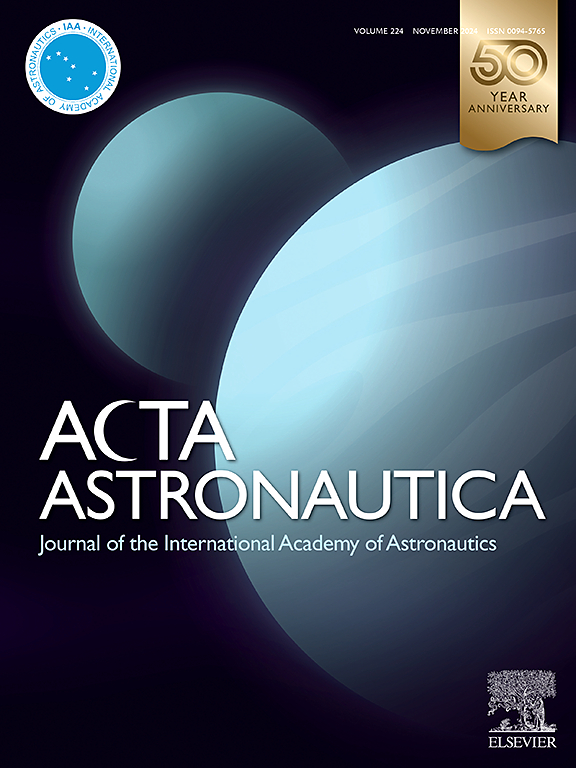关于净弹射角和初始距离对空间碎片捕获的影响的数值和实验研究
IF 3.1
2区 物理与天体物理
Q1 ENGINEERING, AEROSPACE
引用次数: 0
摘要
外层空间空间碎片的数量不断增加,对运行中的航天器构成了重大威胁。因此,网状捕获系统已成为一种很有前途的清除空间碎片的技术。这些系统通过部署网来包围和捕获碎片。使用网捕获碎片的效果取决于弹射参数,如速度、弹射角度以及网与碎片之间的关键初始距离。模拟实验研究了主动清除碎片的各种情况。此外,实验还涉及精心校准的网和碎片抛射系统,通过改变子弹抛射角度 (θ),利用子弹来展开网。使用简化的运动方程确定弹网轨迹,同时考虑弹射动力学及其与碎片的相互作用。这项研究的结果揭示了与空间碎片捕获有关的初始参数和净性能之间的相关性。弹射角度越大,网与碎片之间的距离越远,碎片捕获越受阻。尽管同时进行的网和碎片弹射延迟很小,但实际实验结果验证了模拟结果。本文章由计算机程序翻译,如有差异,请以英文原文为准。
Numerical and experimental study on effects of net-bullet ejection angles and initial distances on space-debris capture
The increasing volume of space debris in the outer space poses a significant threat to operational spacecraft. Hence, net capture systems have emerged as a promising technique for removing space debris. These systems operate by deploying a net to envelop and capture the debris. The effectiveness of debris capture using nets depends on ejection parameters such as speed, ejection angle, and the crucial initial distance between the net and debris. Simulations are performed to examine various scenarios of active debris removal. In addition, the experiments involved meticulously calibrated net and debris ejector systems, where bullets are utilized for net deployment by varying the angle of bullet ejection (). The net trajectory is determined using simplified equations of motion, while considering both the ejection dynamics and its interaction with the debris. The findings of this study reveal the correlations between the initial parameters and net performance pertaining to space debris capture. Larger ejection angles and greater distances between the net and the debris-hindered debris capture. Despite slight simultaneous net and debris ejection delays, the results of the real-world experiments validated the simulation results.
求助全文
通过发布文献求助,成功后即可免费获取论文全文。
去求助
来源期刊

Acta Astronautica
工程技术-工程:宇航
CiteScore
7.20
自引率
22.90%
发文量
599
审稿时长
53 days
期刊介绍:
Acta Astronautica is sponsored by the International Academy of Astronautics. Content is based on original contributions in all fields of basic, engineering, life and social space sciences and of space technology related to:
The peaceful scientific exploration of space,
Its exploitation for human welfare and progress,
Conception, design, development and operation of space-borne and Earth-based systems,
In addition to regular issues, the journal publishes selected proceedings of the annual International Astronautical Congress (IAC), transactions of the IAA and special issues on topics of current interest, such as microgravity, space station technology, geostationary orbits, and space economics. Other subject areas include satellite technology, space transportation and communications, space energy, power and propulsion, astrodynamics, extraterrestrial intelligence and Earth observations.
 求助内容:
求助内容: 应助结果提醒方式:
应助结果提醒方式:


